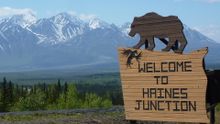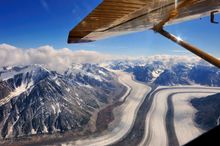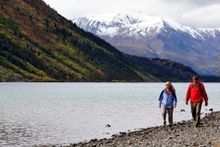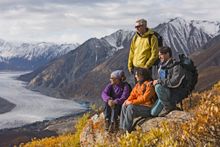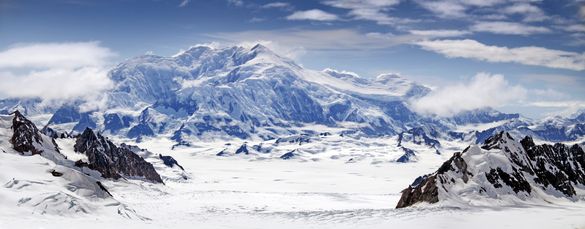 18 Oct 2017
18 Oct 2017
One of the Yukon's great treasures Kluane National Park, is a designated UNESCO World Heritage Site. It contains the wonders of the St. Elias Mountains and its icefields, glacial lakes, wild rivers and pristine forests. Interpretive trails and exhibits will introduce you to the wonders of one of North Americas most awe-inspiring wilderness preserves. A hub for wildlife, it's not uncommon to see grizzly or black bears, Dall sheep, caribou and moose as well as smaller mammals and plenty of birdlife. A profusion of wildflowers bloom during summer and in the fall the aspen forests and tundra create an unforgettable display of colour.
You'll find Kluane National Park and Reserve in the southwestern corner of the Yukon. With its neighbouring parks - Tatshenshini-Alsek Provincial Park (B.C.), Glacier Bay National Park (Alaska), and Wrangell-Saint Elias National Park (Alaska) – it collectively forms one of the largest internationally protected areas on earth, covering an area roughly the size of South Korea, or about twice the size of Switzerland.
Kluane National Park
Canada's tallest peak is in there, so are 5 peaks over 4,500 metres, so is the greatest accumulation of glaciers outside the polar regions, so are a bunch of bears, caribou, moose, wolves and foxes, so is one of the most daunting white water rivers on the planet.
“There” is Kluane National Park. With 8,500 square miles it is Canada's largest national park and a prominent member on the list of UNESCO's World Heritage Sites.
What aren't in there are operational roads or infrastructure of any kind. No, Kluane National Park has been left in peace for our soul.
There are four ways to visit it. Fly over it to get a sense of the unimaginable scope of its icy, mountainous interior; day hike its perimeter, load up your pack and head on in or join a rafting expedition on the Tatshenshini-Alsek river system.
Day hikes abound. They range from an hour to a full day and can take you along rivers, through forests or up mountains. All hikes have been selected for their unique beauty: an alpine lake, a rock glacier, an alpine cirque, a mountain meadow, views into the 4,500 metre Icefield Ranges, opportunities to see wildlife.
But the longer hikes appeal to many. Take the Cottonwood, for instance. On its 51 miles, you travel through spruce forests, trip over two mountain passes, stroll through open alpine meadows and challenge daunting creeks that require as much imagination as courage to cross. Experienced hikers can journey deep into remote areas where there are only routes rather than trails. These journeys involve no-trace camping and require map reading and navigation skills as well as crossing creeks or rivers without bridges. Depending on the route, they offer views of hanging glaciers, cirques and stunning mountain vistas in every direction. It's also possible to start some hikes further into the park with a floatplane ride - one such route is the epic 60 mile Donjek which brings hikers to the toe of the massive Donjek Glacier.
So what's the point? Well, you're in untamed nature, magnificent to look at, challenging to face, inspiring to feel and there's a good chance you'll see who you're sharing it with: Dall sheep, mountain goat, grizzly and black bear, ptarmigan, owl and moose. To understand, you kind of have to be there.
And then there are the forays deep into the park where you may walk where no one has stepped before. You'll need licensed guides for these but we have them, leaders who have the knowledge and expertise to help you understand why Kluane is considered one of the preeminent nature parks on the planet.
Mountains and More Mountains
The St. Elias Mountains in Kluane National Park are the youngest mountains in Canada and also the highest. There are more than 20 summits over 4,200 meters (14,000 ft.), the largest accumulation on the continent. Towering above these lofty peaks is Mount Logan, Canada's highest mountain at 5,959 metres (19,551 ft.), and one of the world's largest massifs. And these mountains are still growing: a seismograph in the Visitor Reception Centre at Haines Junction records hundreds of small tremors that occur every year, pushing the St. Elias Mountains ever skyward.
The Ice Queen
Between the rock massifs of the St. Elias Mountains is one of the largest non-polar icefields in the world. Huge valley glaciers fill the gulfs between the peaks; the Hubbard Glacier is 70 miles long, the Lowell Glacier is 45 miles long and these glaciers may be 1 mile thick in parts. These glaciers make their own weather, scour away tons of rock every day, dam rivers and create lakes.
Galloping Glaciers
The Steele Glacier in Kluane National Park surged for several months in 1966- 67, moving over 1.5 billion tons of ice at a rate of up to 15 metres (50 ft.) per day. Surging valley glaciers are not uncommon in Kluane, where the Lowell Glacier has a history of galloping, blocking the Alsek River and forming a lake. There are more than 2,000 glaciers in Kluane National Park including valley glaciers, hanging glaciers, cirque glaciers and rock glaciers.
If you only do one thing...
With exceptional day hikes and highway-side scenery, Kluane awes from every angle but to truly appreciate its majestic scale and diverse landscapes, there's only one option: take to the skies. Several local companies offer flightseeing tours that take visitors deep into the park's untouched interior. Hop aboard a prop plane or helicopter for a high-altitude view of the Icefield Ranges. Want an even closer look? Special tours touch down in the midst of the icefields, enabling visitors to stay and explore for a few hours or a few days at the Icefield Discovery base camp.
Grand American Adventures offer a 14-day Yukon & Alaska walking tour from £2499 per person. Tel: 0333 220 7850 or visit: www.grandamericanadventures.com
Windows on the Wild offer unique lodges in the Kluane area and surrounds. Tel: 020 8742 1556 or visit: www.windowsonthewild.com


